What is a continuity ball screen offense
A continuity ball screen offense is a basketball offensive strategy that seeks to create scoring opportunities near the basket or near the perimeter areas of the court by utilizing ball screens or pick and roll action with a constant sequence on both sides of the floor.
Which teams could consider a continuity ball screen offense
A continuity ball screen offense could be considered by teams that are guard-oriented as well as teams that possess speed, quickness, the ability to attack the rim, particularly via the ball screens, and/or adequate three-point shooting skills.
Additionally, a continuity ball screen offense could also be beneficial for teams that are undersized, specifically at low post positions.
One notable reason why the continuity ball screen offense could be potentially useful for these types of teams is because the screening actions are generally set by the post players near the wings or the top.
This, in turn, opens up the low post, which also influences the low post defenders to play away from the basket.
Also, at the same time, the open post could make it easier for the guards (or players near the perimeter in general) to dribble drive and attack the basket for scoring opportunities near the rim or kick out three-pointers.
Affiliate Disclosure: I may earn a commission on qualifying purchases made through the links below.
What are examples of scoring options within a continuity ball screen offense
Example 1 – Part 1
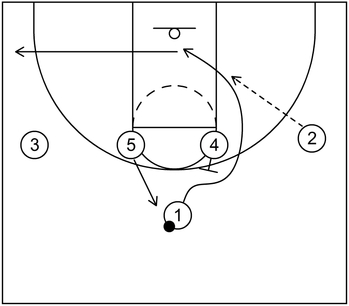
This is an example of a scoring option within a continuity ball screen offense which utilizes a 1-4 high formation. It is derived from Motion and Quick Hitter Offenses Against a Man or Zone Defense by Mark Few, the current head coach at Gonzaga University.
To begin, 2 receives the ball from 1 and after that, 1 cuts to the basket via the UCLA screen set by 4. From there, 1 could receive the ball from 2 and score at the basket if open.
On the other hand, if 1 is not open, then 1 simply fills the left side corner while 5 fills the vacated area at the top.
Example 1 – Part 2
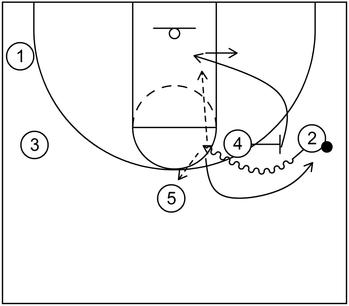
If 1 did not receive the ball, then 2 dribble drives toward the high post area via a ball screen set by 4. Also, 4 rolls to the basket and could receive the ball from 2.
If 4 is not open, then 4 fills the right side low post block. Additionally, 5 receives the ball from 2 and after that, 2 self replaces near the right side wing area.
Example 1 – Part 3
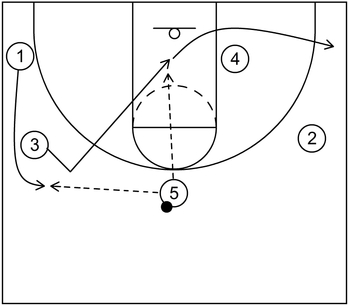
After 5 receives the ball at the top, 3 executes a backdoor cut to the basket. From there, 3 could receive the ball from 5 if that is open.
Otherwise, 3 cuts through and fills the right side corner while 1 fills the vacated left side wing and receives the ball from 5.
Example 1 – Part 4
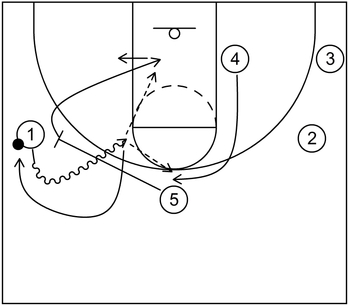
Next, 1 dribbles toward the high post area via a ball screen set by 5. Afterwards, 5 rolls to the basket while 4 replaces at the top.
5 could receive the ball from 1 and score near the basket. If that is not open, then 4 could receive the ball from 1 instead.
Additionally, 5 fills the left side low post block while 1 self replaces near the left side wing area. From this point, the action consists of a backdoor cut with roll and replace continuity pattern.
Example 1 – Part 5
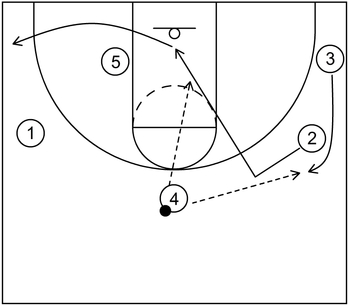
After 4 receives the ball, 2 executes a backdoor cut to the basket. If open, 2 could receive the ball from 4.
If it is not open, then 2 cuts to the left side corner while 3 fills the vacated right side wing and then receives the ball from 4.
Example 1 – Part 6
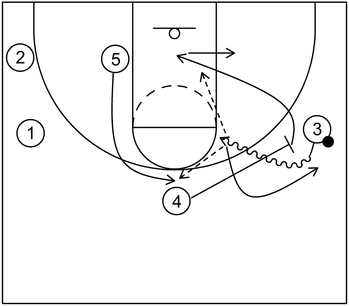
Next, 3 dribbles toward the high post area via the ball screen set by 4. Furthermore, 4 rolls to the basket while 5 replaces at the top.
If 4 is open, then 4 could receive the ball from 3 and score near the basket. Otherwise, 5 receives the ball at the top. Additionally, 4 fills the right side low post block while 3 self replaces at the right side wing.
After that, 1 would execute a backdoor cut and the continuity pattern would keep going indefinitely.
Example 2 – Part 1
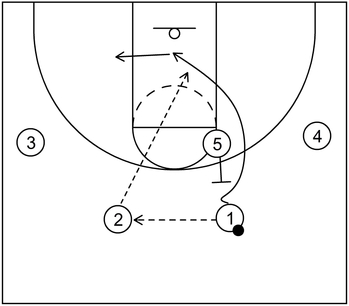
This is an example of a scoring option within a continuity ball screen offense which utilizes a 2-2-1 alignment.
This particular alignment comprises two guards in the slot areas between the wings and the top, two additional players on the wings who could also be guards, as well as one high post player who will typically set screens and roll to the basket.
Essentially, this offensive action could be favorable for teams that are guard-oriented and/or undersized at the low post positions.
It is also derived from The Attacking 3-Out & 4-Out Motion Offense by John Giannini with additional pass and screen away action as well.
To start, 2 receives the ball from 1 and afterwards, 1 cuts to the basket via the back screen set by 5. If 1 is open, then 1 could receive the ball from 2 near the basket. Otherwise, 1 fills the left side low post block.
Example 2 – Part 2

Next, 2 dribbles toward the right side of the court via a ball screen set by 5 while 3 fills the vacated left slot and 1 fills the vacated left side wing area.
After that, 5 rolls to the basket and could receive the ball from 2 if that is open. On the other hand, if 5 is not open, then 3 receives the ball from 2.
Additionally, 4 cuts to the right side slot area via the screen away action set by 2. Also, as that occurs, 2 fills the right side wing area while 5 cuts to the left side high post elbow area.
From this point, the continuity gets initiated with a sequence featuring a back screen, ball screen, and screen away action.
Example 2 – Part 3
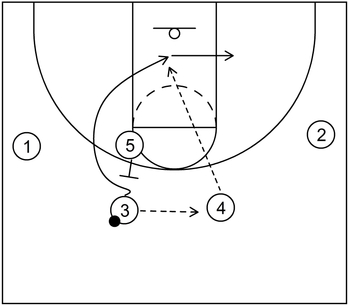
Next, 4 receives the ball from 3 and then, 3 cuts to the basket via the back screen set by 5. If open, 3 receives the ball from 4. If that is not open, then 3 fills the right side low post block.
Example 2 – Part 4
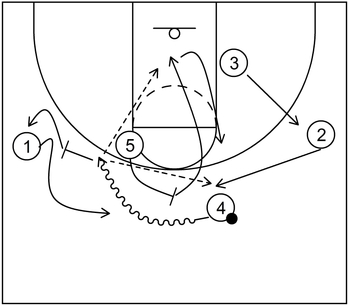
After that, 4 dribbles toward the left side of the court via a ball screen set by 5. As that happens, 5 rolls to the basket while 2 fills the right slot and 3 fills the right side wing area.
From there, 5 could receive the ball from 4 and score near the basket if that is open. If that is not open, then 2 receives the ball from 4 while 1 cuts to the left slot via the screen away action of 4.
Moreover, 4 fills the vacated left side wing area while 5 cuts to the right side high post elbow area.
Example 2 – Part 5

Next, 1 receives the ball from 2 and afterwards, 2 cuts to the basket via the back screen set by 5. If 2 is open, then 2 could receive the ball from 1. If not, then 2 could fill the left side low post block.
Example 2 – Part 6
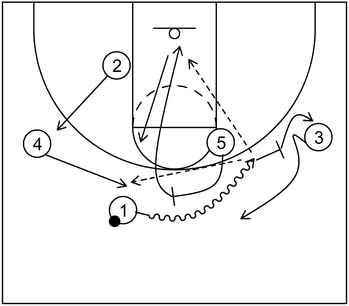
Following that, 1 dribbles to the right side of the court via the ball screen set by 5. Also, 5 rolls to the basket while 4 fills the vacated left slot and 2 fills the vacated left side wing area.
If open, 5 could receive the ball from 1 and score near the rim. Otherwise, 4 receives the ball from 1 and after that, 3 cuts to the right slot area via the away screen by 1.
Furthermore, 1 fills the right side wing area while 5 cuts to the left side high post elbow. From that point, the continuity pattern keeps going indefinitely.